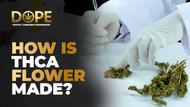How Is THCA Flower Made: Step-by-Step Production Guide
May 30th 2025
How Is THCA Flower Made?
THCA flower is a unique form of cannabis that has gained significant popularity for its non-psychoactive benefits. Unlike traditional cannabis, which contains significant amounts of THC (tetrahydrocannabinol), THCA (tetrahydrocannabinolic acid) is the precursor to THC, making it non-intoxicating in its raw form. This makes THCA flower an appealing choice for those seeking the therapeutic benefits of cannabis without the euphoric high that THC can produce.
What is THCA Flower?
THCA flower refers to the buds of cannabis plants that are rich in tetrahydrocannabinolic acid (THCA). It is primarily found in the trichomes, the resinous glands on the surface of the plant. THCA is a non-psychoactive cannabinoid naturally present in cannabis that can offer various wellness benefits, such as reducing inflammation, supporting joint health, and improving mood.
When THCA is exposed to heat—through smoking, vaping, or cooking—it undergoes a chemical transformation called decarboxylation, which converts THCA into THC, the cannabinoid responsible for the familiar "high" associated with cannabis use.
Step-by-Step Process
1. Selecting the Right Seeds
The journey to THCA flower begins with selecting high-quality cannabis seeds, specifically those known for their high THCA potential. Growers often choose strains like Purple Hindu Kush or Lemon Cherry Gelato based on their genetic predisposition to produce high THCA levels.
2. Germination: The First Step
After selecting the seeds, growers begin with germination, which can be done using methods such as paper towels, soil, or rock wool. Proper germination is critical to kickstart healthy growth, ensuring the plants can reach their full potential.
3. Vegetative Growth: Building the Foundation
Once the seeds sprout, the plants enter the vegetative growth phase. During this stage, the focus is on developing strong roots and sturdy stems. Growers monitor key environmental factors like light, temperature, and humidity to promote healthy plant development.
4. Flowering: THCA Production Peaks
As the plants mature, they enter the flowering phase, which is crucial for THCA production. During flowering, trichomes (the resin glands on the buds) begin to accumulate THCA. The plant's light cycle is adjusted to trigger this phase, maximizing the THCA buildup in the trichomes.
5. Harvesting: Timing is Key
The timing of harvest is critical for preserving THCA content. Growers closely monitor the trichomes, waiting for them to turn milky or cloudy. This indicates peak THCA production. Harvesting too early or too late can significantly lower THCA levels.
6. Hand-Harvesting for Quality
To preserve the delicate trichomes, THCA flowers are typically hand-harvested. This ensures that the buds are handled with care, minimizing damage and maintaining the THCA content. After harvesting, the flowers are carefully trimmed to remove any excess leaves and stems, leaving behind the prized THCA-rich buds.
7. Post-Harvest: Drying and Curing
After harvest, the buds undergo drying and curing. These processes help maintain the potency of the THCA while preventing its conversion into THC. Proper temperature and humidity control during curing are essential for maintaining the flower's quality and maximizing its THCA content.
8. Extraction: Preserving THCA Integrity
In some cases, THCA can be extracted for use in concentrates or other products. This is done through various methods like solvent-based extraction or solventless techniques such as rosin pressing. These extraction methods preserve the integrity of THCA, ensuring it remains non-psychoactive until heated.
9. Lab Testing for Purity and Potency
Once the THCA flower is ready for sale, it undergoes independent lab testing. These tests verify the THCA content and check for contaminants like pesticides and heavy metals. Transparency in lab results ensures consumers receive a pure, high-quality product.
10. Packaging and Distribution
Finally, the THCA flower is carefully packaged to preserve its freshness and potency. High-quality packaging ensures that the buds maintain their THCA content until they reach the consumer.
Conclusion
The process of making THCA flower is an art and science, requiring attention to detail at every stage, from seed selection to harvest. By following precise cultivation, harvesting, and post-harvest procedures, growers can produce high-quality THCA flower that meets the demands of consumers. Whether for non-psychoactive wellness or THC activation through decarboxylation, the journey of THCA flower showcases the dedication to producing a pure, potent product.

